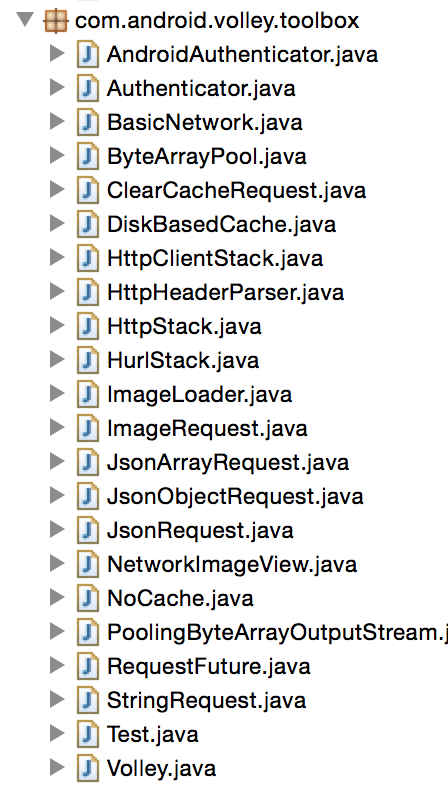在Android Volley分析(一)——结构中主要分析了Volley的基本组件和框架结构,组件主要是定义的接口,也就是说我们可以实现这些接口来定制自己的Volley版本,比如NetWork、Cache、Request等等。Android Volley在com.android.volley.toolbox下已经做了这些工作,下面就看看这些具体的实现内容
先看一个Volley使用的例子
final TextView mTextView = (TextView) findViewById(R.id.text);
...
// Instantiate the RequestQueue.
RequestQueue queue = Volley.newRequestQueue(this);
String url ="http://www.google.com";
// Request a string response from the provided URL.
StringRequest stringRequest = new StringRequest(Request.Method.GET, url,
new Response.Listener() {
@Override
public void onResponse(String response) {
// Display the first 500 characters of the response string.
mTextView.setText("Response is: "+ response.substring(0,500));
}
}, new Response.ErrorListener() {
@Override
public void onErrorResponse(VolleyError error) {
mTextView.setText("That didn't work!");
}
});
// Add the request to the RequestQueue.
queue.add(stringRequest);这是官方volley教程的一个 例子,使用Volley的步骤
1、Volley.newRequestQueue();
2、new Request();
3、queue.add(request);
在newRequestQueue的时候会初始化基本的组件
public static RequestQueue newRequestQueue(Context context, HttpStack stack) {
File cacheDir = new File(context.getCacheDir(), DEFAULT_CACHE_DIR);
String userAgent = "volley/0";
try {
String packageName = context.getPackageName();
PackageInfo info = context.getPackageManager().getPackageInfo(packageName, 0);
userAgent = packageName + "/" + info.versionCode;
} catch (NameNotFoundException e) {
}
if (stack == null) {
if (Build.VERSION.SDK_INT >= 9) {
stack = new HurlStack();
} else {
// Prior to Gingerbread, HttpUrlConnection was unreliable.
// See: http://android-developers.blogspot.com/2011/09/androids-http-clients.html
stack = new HttpClientStack(AndroidHttpClient.newInstance(userAgent));
}
}
Network network = new BasicNetwork(stack);
RequestQueue queue = new RequestQueue(new DiskBasedCache(cacheDir), network);
queue.start();
return queue;
}1、BasicNetwork
BasicNetwork是对Network接口的实现,同时还将联网操作部分提取出来形成HttpStack,原因是Android 2.3之前网络操作推荐使用HttpClient,2.3之后Android做了优化推荐使用HttpUrlConnection。
2、DiskBasedCache
DiskBasedCache是对Cache对实现,用于硬盘缓存,也就是将数据保存为特定的文件。
结合LruCache试着总结一下缓存的一般方法:
映射结构——LinkedHashMap,内部实现了Lru的算法排序,可以直接使用
put——存储,容量计数增加,判断是否超出最大容量,超出则删除最少使用的
get——key到entry的映射
remove——删除,容量计数减小
3、ImageLoader
ImageLoader是一个图片加载类,封装了请求,提供了内存缓存机制,批处理等,让图片加载更容易使用,下面看一下它的用法:
mImageLoader = new ImageLoader(mRequestQueue,
new ImageLoader.ImageCache() {
private final LruCache<String, Bitmap>
cache = new LruCache<String, Bitmap>(20);
@Override
public Bitmap getBitmap(String url) {
return cache.get(url);
}
@Override
public void putBitmap(String url, Bitmap bitmap) {
cache.put(url, bitmap);
}mImageLoader.get(IMAGE_URL, ImageLoader.getImageListener(mImageView,
R.drawable.def_image, R.drawable.err_image));(示例来源 Making a Standard Request )
内存缓存推荐使用LruCache,需要实现ImageLoader.ImageCache接口。图片的加载通过imageLoader.get()方法实现,
public ImageContainer get(String requestUrl, ImageListener imageListener,
int maxWidth, int maxHeight) {
// only fulfill requests that were initiated from the main thread.
throwIfNotOnMainThread();
final String cacheKey = getCacheKey(requestUrl, maxWidth, maxHeight);
// Try to look up the request in the cache of remote images.
Bitmap cachedBitmap = mCache.getBitmap(cacheKey);
if (cachedBitmap != null) {
// Return the cached bitmap.
ImageContainer container = new ImageContainer(cachedBitmap, requestUrl, null, null);
imageListener.onResponse(container, true);
return container;
}
// The bitmap did not exist in the cache, fetch it!
ImageContainer imageContainer =
new ImageContainer(null, requestUrl, cacheKey, imageListener);
// Update the caller to let them know that they should use the default bitmap.
imageListener.onResponse(imageContainer, true);
// Check to see if a request is already in-flight.
BatchedImageRequest request = mInFlightRequests.get(cacheKey);
if (request != null) {
// If it is, add this request to the list of listeners.
request.addContainer(imageContainer);
return imageContainer;
}
// The request is not already in flight. Send the new request to the network and
// track it.
Request<?> newRequest =
new ImageRequest(requestUrl, new Listener<Bitmap>() {
@Override
public void onResponse(Bitmap response) {
onGetImageSuccess(cacheKey, response);
}
}, maxWidth, maxHeight,
Config.RGB_565, new ErrorListener() {
@Override
public void onErrorResponse(VolleyError error) {
onGetImageError(cacheKey, error);
}
});
mRequestQueue.add(newRequest);
mInFlightRequests.put(cacheKey,
new BatchedImageRequest(newRequest, imageContainer));
return imageContainer;
}首先得到一个cacheKey,这个是统一的规则
private static String getCacheKey(String url, int maxWidth, int maxHeight) {
return new StringBuilder(url.length() + 12).append("#W").append(maxWidth)
.append("#H").append(maxHeight).append(url).toString();
}然后在缓存cache中查找,没找到就讲请求添加到批处理任务BitmapImageRequest中,这里有两个类,ImageContainer和BitmapImageRequest:
ImageContainer是一个包装类,里面包含了bitmap、url、cacheKey和listener,当得到bitmap后会通过listener将bitmap返回;
BitmapImageRequest是将相同url请求放在一起,这样就可以只向网络请求一次,返回结果后再分别设置到目标上,从而达到减少网络请求对目的。























 893
893

 被折叠的 条评论
为什么被折叠?
被折叠的 条评论
为什么被折叠?








